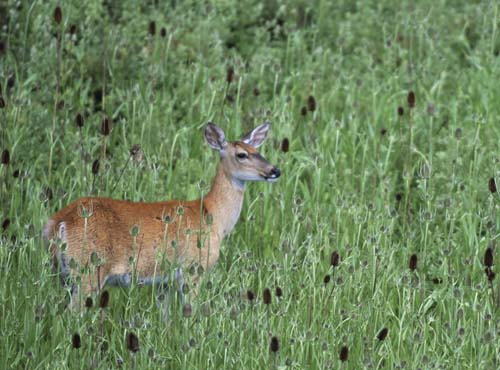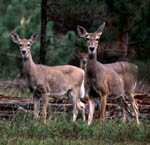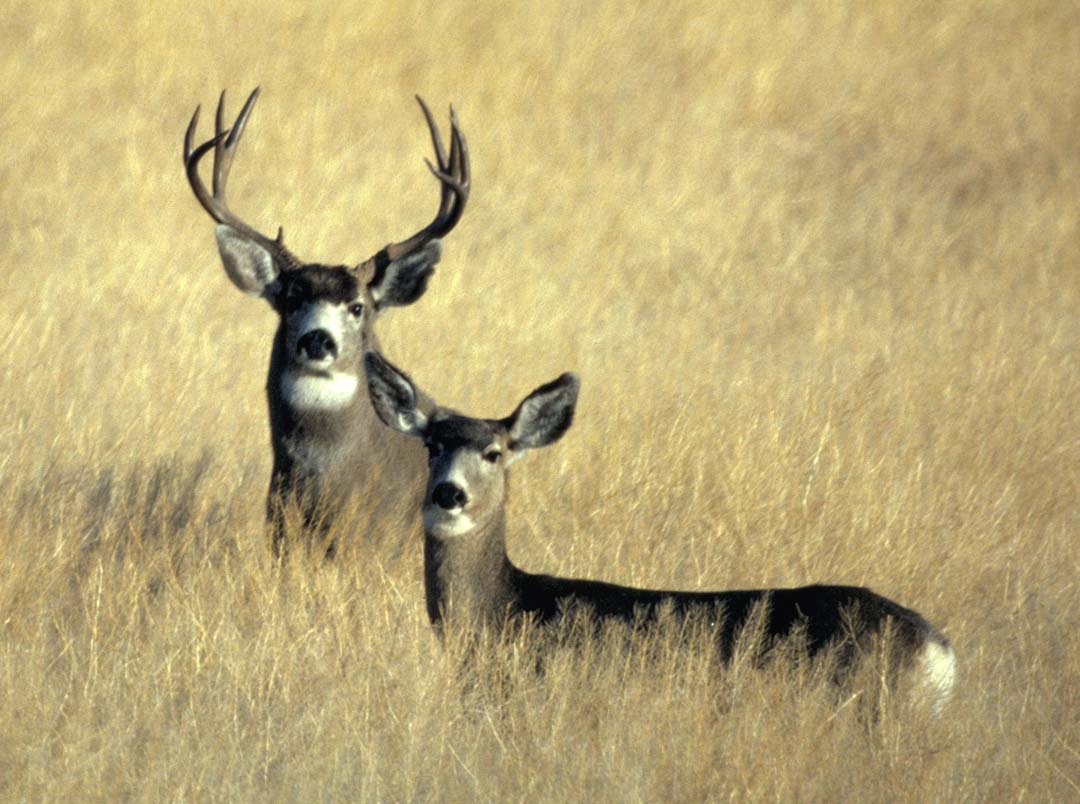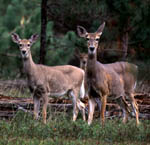Epizootic hemorrhagic disease (EHD) has been confirmed in South Dakota. Also, the disease, reported in North Dakota earlier this year, has lead to the suspension of some hunting licenses and offers of refunds for more in that state.
Category Archives: deer
EHD in Maryland
Epizootic hemorrhagic disease (EHD) was reported in white-tailed deer in Maryland last week, but it seems likely that the outbreak will be short-lived. Biting midges, or no-see-ums, transmit the disease-causing virus, and outbreaks generally end with a hard frost.
Western Maryland, where the two cases of EHD were reported, received about six inches of snow this weekend. That should end the biting midges’ party for the season.
Read the article on the outbreak in the Hagerstown Herald-Mail.
I couldn’t find a Maryland Department of Natural Resources press release on the outbreak, but the department does have an EHD fact sheet on-line.
As the Herald-Mail article mentions, Chronic Wasting Disease (CWD) is a much bigger concern than EHD in this southern-ish state. Here’s our post on CWD in Maryland.
Also, read this previous post on EHD for links to more information on the disease.
Photo: A healthy white-tailed deer. Credit: Ryan Hagerty, courtesy of US Fish and Wildlife Service
CWD in Missouri, Again
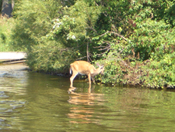 Chronic wasting disease (CWD) was found in captive white-tailed deer in Macon County, Missouri last week. In 2010, another captive deer operation in Linn County, Missouri, run by the same group, was found to have CWD. Those deer were all killed and no deer at the facility have tested positive for CWD since.
Chronic wasting disease (CWD) was found in captive white-tailed deer in Macon County, Missouri last week. In 2010, another captive deer operation in Linn County, Missouri, run by the same group, was found to have CWD. Those deer were all killed and no deer at the facility have tested positive for CWD since.
The state’s CWD contingency plan, announced in 2003, has been activated in response to the recent discovery.
I was surprised not to find a press release about this from the Missouri Department of Conservation on its site, but here’s the press release from the Missouri Department of Agriculture. Most of the coverage I’ve seen so far merely reprints that press release.
For sample response plans, see this list of CWD policy resources from the Chronic Wasting Disease Alliance.
Michigan, North Carolina and Virginia have response plans on the list, but not Missouri. The top of the page has national and federal resources, so scroll down for state policies.
Wondering where CWD is now? Here’s a map from the Chronic Wasting Disease Alliance.
Photo: This white-tailed deer in Wisconsin has CWD. Photo Credit: Wisconsin Department of Natural Resources
Hot Weather and Urban Deer Hunters
When the temperature approaches the 80s, do deer hunters stay home? A recent press release from the Missouri Department of Conservation shows that fewer deer were killed during urban deer hunts in years when the weather is warm than in years with more seasonable temperatures.
Similar trends are seen during regular hunting seasons, but the result is more acute during urban hunts, because they may only last a day or a few days.
The nicest thing about this press release is that it offers a few years of data, with the number of deer killed and the temperature. Add it to or compare it with your own data from urban hunts for some possible insight. Read more here.
If you are interested in urban deer, don’t miss the current issue of The Wildlife Society Bulletin, which focuses on urban deer. Articles include contraceptive use, the influence of roads and various controlled hunt issues. Read more here. (Fee or subscription required.)
Photo: courtesy of the Michigan Department of Natural Resources
Controversy in NC Deer Killing
On September 20 North Carolina Wildlife Resources Commission officials killed seven fallow deer and two white-tailed deer being held in an unlicensed deer rehabilitation facility in Randolph County. (More here.) In August they killed two fawns being held without a permit or rehabilitator’s license in Surry County.
The locals are pretty steamed. There’s a petition posted in the local grocery store. (Read about it here.) And one on-line.
The controversy was fed by conflicting reports of the exact method used to kill the deer: shotgun, rifle or bolt. Also, two “uniformed officials” demanded that the grocery store petitions be taken down. (Story here.) Although, that could have been anyone, including some Frito delivery guys.
The flames have been fanned by the local Fox News outfit, which has done several stories on the situation, including one, just to make it fair and balanced, with the Commission’s defense of the shootings.
Rounding out the coverage was a story on the lawsuit filed against the state by the couple who were illegally holding the deer.
A copy of what is supposed to be an NC Wildlife Resources Commission press release has been posted by the Fox station, but is not available through the Commission’s Web site. Read it here. A different statement from the Commission appeared on the Ammoland blog, which frequently posts press releases from state wildlife agencies. Read that one here.
Enforcing captive wildlife laws has always been sensitive. This is all food for thought as society moves farther away from understanding animals as wildlife, and only relates to them as pets or food. (Does anyone remember Pete the Moose?)
(And in a weird co-incidence, Pete the Moose died around Oct. 14, shortly after we posted that aside. Read the story in the Burlington Free-Press.)
Photo: Lots of photos of cute fawns illustrated the Fox stories on the controversy. This cute fawn picture is not of any of the animals involved. It’s by Tom Stehn, courtesy US Fish and Wildlife Service.
When Deer Attack
On September 30, a woman was attacked by a mule deer buck in southeast Idaho and was severely injured. She was rescued by a man, who was also injured, and his teenage daughter. I saw this press release from the Idaho Fish and Game Department yesterday, but didn’t think it was worth your time. These things happen, occassionally.
However, the story has been picked up by the Washington Post, Forbes and other major news outlets (which are all picking up the same Associated Press story). It has the potential to be one of those media-created issues (the New Year’s Eve blackbird “Aflockalypse” comes to mind), so you, as a state wildlife biologist, should know about it before you start getting phone calls. (And yes, I write that knowing that I am part of the media.)
Photo: Not guilty. These mule deer were photographed in California by Tupper Ansel Blake, and appear courtesy of the US Fish and Wildlife Service for illustrative purposes. They didn’t attack anyone (that we know of).
When Deer Attack
On September 30, a woman was attacked by a mule deer buck in southeast Idaho and was severely injured. She was rescued by a man, who was also injured, and his teenage daughter. I saw this press release from the Idaho Fish and Game Department yesterday, but didn’t think it was worth your time. These things happen, occassionally.
However, the story has been picked up by the Washington Post, Forbes and other major news outlets (which are all picking up the same Associated Press story). It has the potential to be one of those media-created issues (the New Year’s Eve blackbird “Aflockalypse” comes to mind), so you, as a state wildlife biologist, should know about it before you start getting phone calls. (And yes, I write that knowing that I am part of the media.)
Photo: Not guilty. These mule deer were photographed in California by Tupper Ansel Blake, and appear courtesy of the US Fish and Wildlife Service for illustrative purposes. They didn’t attack anyone (that we know of).
EHD in Michigan
Two white-tailed deer have been diagnosed with epizootic hemorrhagic disease (EHD) in a southwestern county of Michigan. Last year 250 deer in that Michigan county died of the disease.
A Michigan Department of Natural Resources press release has the details of the finding, plus a history of EHD in the state. The release states: “More frequent outbreaks of EHD in Michigan could be a consequence of climate changes that favor the northward spread of the biting flies that spread the disease, said Russ Mason, chief of the DNR Wildlife Division.”
EHD is endemic to North America. The disease is most common in white-tailed deer, but can infect all ruminants. Humans are not known to catch the disease.
Few deer die from the disease in the southeastern U.S., which experiences a mild form of the disease. Outbreaks in the Midwest and Northeast can range from a small outbreak with few deaths to something more widespread. The severity of the outbreak depends on the weather (wet weather favors breeding midges), how many of the biting midges are around, herd immunity, and other factors.
Epizootic Hemorrhagic Disease in Penn.
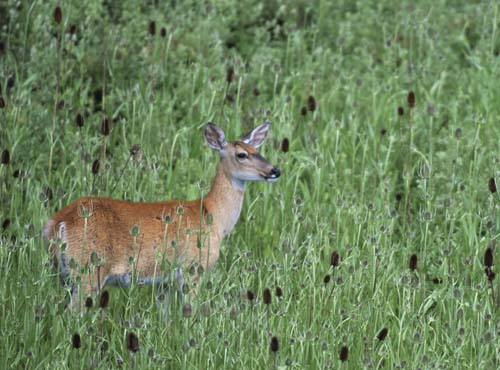 One captive deer in Erie County, in the northwestern corner of the state, has also died of EHD, according to a Pennsylvania Game Commission press release.
One captive deer in Erie County, in the northwestern corner of the state, has also died of EHD, according to a Pennsylvania Game Commission press release.Photo: A healthy white-tailed deer. Credit: Ryan Hagerty, courtesy of US Fish and Wildlife Service
Epizootic Hemorrhagic Disease – Update
It is the season of biting midges, and therefore the season for epizootic hemorrhagic disease in deer.
In Kansas, there have been several reports of dead or dieing deer. Two of those cases have been confirmed as epizootic hemorrhagic disease (EHD), or EH, as this article in InfoZine that reported the outbreak calls it. Read the story here.
EHD is cited as the likely source of dead and dieing deer in Montana, in this article from the Liberty County Times.
Read the ProMed entries on both these events for background, wise commentary and corrections to the articles. The comments are at the bottom of the page in [brackets]. Read it here.
There is a possible outbreak in North Dakota. It is still being investigated. Read the story in the Bismark Tribune.
And finally, two weeks ago New Jersey announced a possible outbreak of EHD. We posted that as an addition to that week’s wildlife disease update, but in case you missed it, here’s the press release.
Late addition: On Sept. 7, 2011, New York State has announced that the death of 100 deer in Rockland County two weeks ago was caused by EHD. Read the press release here.
Photo: A healthy deer. Photo credit: Steve Hillebrand, courtesy US Fish and Wildlife

